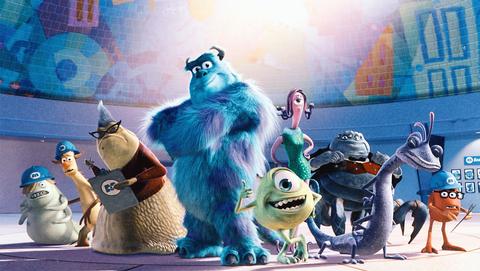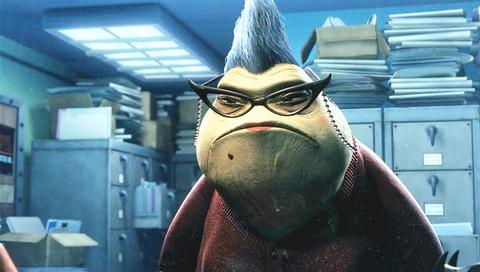Freaks, mutants and misshapen creatures shambling off to work -- no, it's not a documentary about rush hour on the New York subway system. This is the premise of Pixar's newest brightly colored, computer-animated feature, Monsters Inc.
Pixar Animation Studios has now so streamlined the process that you may find yourself eagerly awaiting the release of Monsters on video so you can take in all the myriad visual jokes planted all over the frame, a form of visual invention that adds an extra tickle to the picture. Not that Monsters needs it; in a final reversal of events, Pixar has given Disney, which financed the film, the last leg up by stealing the style and speed of Warner Brothers cartoons, which used to ridicule Disney's do-gooder ethos.

PHOTO COURTESY OF BUENA VISTA
The breakneck wit of Monsters Inc covers a lot of ground and makes fun of everything from the paranoid thrillers of the 1970's to the self-mythologizing needs of the mass media as well as the cartoon form. The opening credits evoke the clean lines and bop dizziness of UPA, the studio responsible for Gerald McBoing-Boing in the 1950's. No big deal is made of this, though; the joke is dropped and Monsters streaks along.

PHOTO COURTESY OF BUENA VISTA
Monsters, Inc is a company that sends kids screaming into their parents' bedrooms; it employs the creatures that ominously lurk inside closets and give children the frights. Closets are the entry into the regular world from the creatures' own home universe. The impetus to create fear comes out of self-interest; in Monstropolis, the freakazoid parallel dimension in which the monsters live, children's screams are used as a power source. But that power is drying up because kids don't scare so easily anymore.
One Monsters, Inc employee still exceeds his mandated scare quota: Sullivan (the voice of John Goodman), a furry blue-and-purple giant whose design specs may have come from a 1970s dorm room. His best pal is his one-man crew, Mike (Billy Crystal), a bouncy, bile-green little guy who would have a chip on his shoulder if he had shoulders; the ovoid Mike is one big eye with a really big mouth, arms and legs. (You'll choke on laughter as he tries to slip in his single, hubcap-size contact lens.)
Sullivan is the champ, and his boss and mentor, Mr Waternoose (James Coburn), sums up Sully's technique for a group of auditioning monsters. "It's all about presence, about how you enter the room," Waternoose pontificates.
Like any classic cartoon character, Mike is a textbook case of manic depression. He zooms from high to lows to tantrums faster than any 3 year old, even Boo (Mary Gibbs), the 3-year-old human who puts all of Monstropolis, and specifically Sully and Mike, in danger.
Any artifact from the human world is a contaminant; when one hapless monster returns from a scare jaunt with an innocent-looking sock caught on his fur, he's attacked by a decontamination team, a group that subjects him to a special group of terrors to keep Monstropolis sterile. (This may be an unfortunate time to joke about a threat of contamination, but the rubber-suited mop-up squad -- latex tight over their odd shapes -- is a great sight gag.) When Boo enters Monstropolis, panic erupts and it's up to Sully and Mike to return her without being blamed for the mishap.
"Loch Ness, Big Foot, they all have one thing in common -- banishment," Mike sputters, mentioning the ultimate punishment. And they have to stay out of the way of their vile competitor, Randall (Steve Buscemi), who lives to overtake Sully's fabulous stats.
This all leads to a chase that features slamming closet doors leading to many locations. And the alternative-energy conclusion itself could make another movie. For a movie about an energy crisis, there hasn't been a film in years to use creative energy as efficiently as Monsters Inc; this is one clean-burning engine that doesn't waste a joke or a thought. The hot hues of the picture's color scheme are thought through; the shininess makes the film look as if it's set in an overly bright factory.
Monsters gets a little sticky in the end, which is apparently axiomatic, since feature-length cartoons are required to celebrate childhood in a rather square way. The film takes some mild shots at the jaded little members of its target audience, but it doesn't really want to upset them or their parents.
Monsters may also be compared a little unfavorably with the director John Lasseter's Pixar work, including the Toy Story movies and A Bug's Life. It took Lasseter a while to achieve something like the ending of Toy Story 2, when Buzz the astronaut and Woody the cowboy talk like a couple of heroes from a John Ford western closing out a film; there was a surprising iconic majesty, with earned emotional attachment because of what they endured.
The Monsters Inc director, Peter Docter, makes his own inroads. He knows how funny it is to get the matching basso rumbles from Goodman and Coburn as a de facto father-and-son pair. He knows that older viewers will enjoy Crystal's recycling of the put-upon Jersey screech of one of his old Saturday Night Live characters, the sour-faced masochist Willie, who talked about how much he hated getting a potato peeler stuck up his nose.
Docter; his story co-creators, Jill Cultan, Jeff Pidgeon and Ralph Eggleston; and the screenplay writers, Andrew Stanton and Daniel Gerson, get in a few digs at Toy Story and turn the fake-looking humans of computer animation into a canny joke early on. And they must be amused about persuading Disney to finance a comedy that is, finally, about anti-corporate behavior.
What makes Monsters Inc so wonderful is that it's about scream deficit, yet all great cartoons are powered by screams. It's a tribute to noise, so how can you not fall in love with it?

In the March 9 edition of the Taipei Times a piece by Ninon Godefroy ran with the headine “The quiet, gentle rhythm of Taiwan.” It started with the line “Taiwan is a small, humble place. There is no Eiffel Tower, no pyramids — no singular attraction that draws the world’s attention.” I laughed out loud at that. This was out of no disrespect for the author or the piece, which made some interesting analogies and good points about how both Din Tai Fung’s and Taiwan Semiconductor Manufacturing Co’s (TSMC, 台積電) meticulous attention to detail and quality are not quite up to

April 21 to April 27 Hsieh Er’s (謝娥) political fortunes were rising fast after she got out of jail and joined the Chinese Nationalist Party (KMT) in December 1945. Not only did she hold key positions in various committees, she was elected the only woman on the Taipei City Council and headed to Nanjing in 1946 as the sole Taiwanese female representative to the National Constituent Assembly. With the support of first lady Soong May-ling (宋美齡), she started the Taipei Women’s Association and Taiwan Provincial Women’s Association, where she

It is one of the more remarkable facts of Taiwan history that it was never occupied or claimed by any of the numerous kingdoms of southern China — Han or otherwise — that lay just across the water from it. None of their brilliant ministers ever discovered that Taiwan was a “core interest” of the state whose annexation was “inevitable.” As Paul Kua notes in an excellent monograph laying out how the Portuguese gave Taiwan the name “Formosa,” the first Europeans to express an interest in occupying Taiwan were the Spanish. Tonio Andrade in his seminal work, How Taiwan Became Chinese,

Mongolian influencer Anudari Daarya looks effortlessly glamorous and carefree in her social media posts — but the classically trained pianist’s road to acceptance as a transgender artist has been anything but easy. She is one of a growing number of Mongolian LGBTQ youth challenging stereotypes and fighting for acceptance through media representation in the socially conservative country. LGBTQ Mongolians often hide their identities from their employers and colleagues for fear of discrimination, with a survey by the non-profit LGBT Centre Mongolia showing that only 20 percent of people felt comfortable coming out at work. Daarya, 25, said she has faced discrimination since she